More than a Museum: Life & Lodging at Rosson House
Posted April 1, 2025
Written by Heather Roberts, Research Historian
For a printer-friendly, PDF version of this article, please click here.
Author’s Note: I’ve been researching and writing articles for our history blog for almost 9 years now, long before I was given the title, Research Historian. And though I’ve thoroughly enjoyed exploring all that history, the work I’ve been doing over the last year under my new title has been some of the most enjoyable and rewarding – searching for the people who lived and lodged at Rosson House. Getting the chance to add to the known history of this local landmark is an indescribable honor, and I’m grateful to get to share it with you! See a list of Rosson House lodgers here.
Did you know…
Over the last 45 years, people have visited Rosson House Museum to see what life was like in Territorial Phoenix at the turn of the 20th century. Our stories have covered the original four families who owned the home – the Rossons, Goldbergs, Higleys, and Gammels – as well as Whitelaw Reid, the wealthy “snowbird” who rented the home from the Rossons during the winters of 1895-6, and 1896-7. Our narrative hasn’t strayed much from these people, nor from the years they occupied the home, up to about 1920. But so many more people lived at the home over the years, renting rooms at Rosson House from at least 1900 until just before restoration began in the 1970s. And while those people have up until now been largely overlooked, we’re on a mission to make sure their histories are not forgotten.
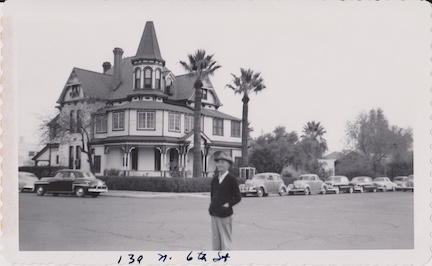
Rosson House, circa 1950. We believe the balcony
was fully enclosed, as it is here, around World War II.
“Why should we remember them?” you might ask. Because it’s a part of not only our history at The Square – the owners of every house here either rented out their home or rented out rooms in their home at one time or another – it’s also a part of our nation’s history, as even Colonial Era immigrants often outnumbered available housing. In the 19th century, somewhere between a third to a half of all urban US residents either took in boarders or lodgers, or were boarders or lodgers themselves. Taking in boarders was a way for an individual or family to supplement their income – particularly for women, who had less opportunity for “respectable” employment outside the home. Though this trend waned in the 20th century, particularly after the second world war when rising living standards and a boom in construction made home ownership more affordable, there was still a need for cheaper housing.
Getting Started
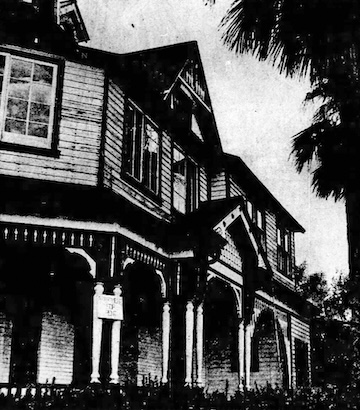
A picture of Rosson House, published in the Arizona Republic on December 1, 1955. Note the sign on the front porch that reads: “Apartments for Rent”.
None of the owners of Rosson House left records of those who boarded or lodged there. With information gathered from our collection and archives, we initially knew the names of about 37 people who lived at Rosson House, outside of the original families. With the release of the 1950 Census in 2022, we were able to discover 12 additional names. An email from the grandson of a woman who lived at Rosson House in the 1950s gave us her name, bringing us up to 50. But it was an exhaustive search through digital records over the last year that added over 90 more names to our list.
To find these previously unknown people, I had to look for the place – 139 North Sixth Street – instead of their names, which made the search more challenging. And as difficult as it’s been to try and find people without knowing their names, searching for the known individuals has come with its own set of mountains to climb. Not all information is available digitally, the transcription of documents and records isn’t always correct, spelling of names can vary, and data about some groups of people, including minorities, women, children, and those who were impoverished and/or transitory, can often be incomplete.
Undaunted, I combed through local newspapers, city directories, censuses, voter registrations, death records, and draft registrations, and discovered additional information about several of the people I found in birth, marriage, naturalization, and military service records, passenger manifests, and even a US Civil War pension file. As of this date, we now know about 145 names of people who rented rooms at Rosson House.
A Work in Progress
 Though our history of the Gammel family had linked their decision to take in lodgers to the passage of Arizona Prohibition laws in November 1914, a classified ad published in the Arizona Republican newspaper through September and October of that year (seen here) seems to suggest otherwise. The fact that they were advertising rooms for rent a full two months before the Prohibition vote could indicate that renting out rooms for additional income may have been part of the Gammel’s plan for Rosson House from the start.
Though our history of the Gammel family had linked their decision to take in lodgers to the passage of Arizona Prohibition laws in November 1914, a classified ad published in the Arizona Republican newspaper through September and October of that year (seen here) seems to suggest otherwise. The fact that they were advertising rooms for rent a full two months before the Prohibition vote could indicate that renting out rooms for additional income may have been part of the Gammel’s plan for Rosson House from the start.
Boarding House: A private house in which accommodation and meals are provided for paying guests.
Lodging House: A house in which rooms are rented, especially a house other than an inn or hotel; rooming house.
In a 1987 interview with long-time Rosson House volunteer, Vicki Beaver, Georgia Gammel Valliere recalled that her mother ran a rooming or lodging house, where most renters would cook their meals on hot plates or dine out. The Gammels made an exception for a few lodgers who were closer to the family – this included John “Shorty” Brummer, Bob Feddersen, and Newel Ponder – as well as for the St. Mary’s students who boarded with them during World War II (and whose names I haven’t yet been able to find).
With further research, I’ve been able to start piecing together the backgrounds of some of these newly discovered residents (a full list of lodgers is available here). I couldn’t decide on just a few to share with you, so here are several for you to explore:
Henry Christoph and Louis Migel: Listed in the 1900 Census at Rosson House as living with the Goldberg family, Henry and Louis are the first lodgers that we know of at that residence. Henry was a miner and an immigrant from Holland. Louis was also an immigrant, though from Russia. Louis was also Aaron Goldberg’s brother-in-law, so it’s no surprise he worked as a clerk at the Goldberg Bros clothing store.

“Hurley Meat Co. Building Exterior,” McCulloch Brothers Inc. Photographs, CP MCLMB A2023A. ASU Libraries: Arizona Collection.
John C. Hurley: The 1912 Phoenix City Directory lists John at Rosson House at the same time the Higleys owned the home, as does his voter registration from that year. However, we can’t be sure if he was a lodger, a boarder, or just a friend. He was a stockman (i.e. – a person who raises livestock), and was likely the John C. Hurley who founded the meat packing industry in the Phoenix area.
Frank and John Berg: Frank and John were cousins who were listed at Rosson House in the 1915 Phoenix City Directory. Frank was an Assistant Hydrographer (i.e. – a person who measures and maps bodies of water) with the US Reclamation Service, and John was a repairman with JH Lane, a motorcycle shop. They are both mentioned in the Arizona Republican newspaper in connection with motorcycle racing around that time period.
Catherine Power: Several classified ads in the Arizona Republican newspaper from January through April 1915 promote Catherine as a Graduate Masseuse, doing business there at Rosson House, like this one from January 7, 1915, which reads: “Scientific body massage, Swedish movements (9 a.m. to 6 p.m.) Evenings by appointment. Miss Catherine Power, 139 N. 6th Street. Phone 8803.”
C. A. M. : This unknown person advertised in the December 31, 1916, Arizona Republican newspaper classifieds: “LOST – Gold bracelet with the initials C. A. M., set with amythist [sic]. 139 N. Sixth St.” Currently, there is no resident of Rosson House on our list with those initials from that time period. However, it could be a piece of jewelry inherited from a family member, or possibly even someone whose initials changed after marriage.
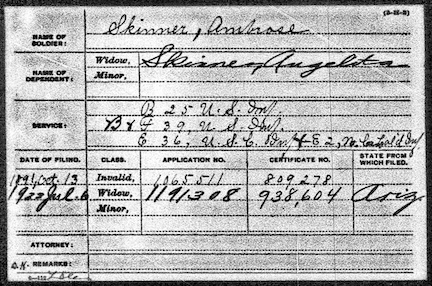 Angelita Skinner: Angelita’s death certificate, dated November 15, 1927, lists Rosson House as her residence. But the surprise came when we found her listed as the widow of Ambrose Skinner on his Civil War pension file (seen here). Ambrose was a veteran of the Civil War and a Buffalo Soldier. He passed away in 1922 at the age of 96 – Angelita was around 54 years his junior.
Angelita Skinner: Angelita’s death certificate, dated November 15, 1927, lists Rosson House as her residence. But the surprise came when we found her listed as the widow of Ambrose Skinner on his Civil War pension file (seen here). Ambrose was a veteran of the Civil War and a Buffalo Soldier. He passed away in 1922 at the age of 96 – Angelita was around 54 years his junior.
Marrian Bales (as Mrs. C. C. Bales): Though she was a California resident, a newspaper article in the Arizona Republican (April 17, 1928) lists Marrian’s temporary Phoenix address as 139 N. Sixth St. while she searched for her 20 year old son, Kenneth, who had travelled to Arizona from Tacoma seven months earlier for his health. The newspaper never followed up on the story, but in the 1930 census, Marrian was back in California and her son was living with the family.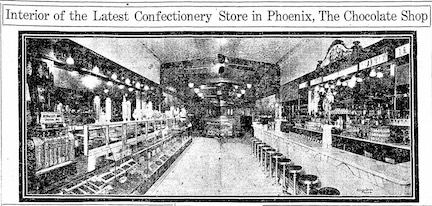
James, Thomas, and August Georgouses: Listed at Rosson House in the 1919 Phoenix City Directory, the Georgouses brothers emigrated from Greece to the United States around 1909, along with their other brothers Tony, Pete, Nick, and John, their sister, Georgia, and their mother, Aspacia. They owned several local businesses, including Busy Bee Cafe, The Chocolate Shop (pictured here from the Arizona Republican, October 30, 1919), the Portola Cafe, and the Athens Hat Works. Their maternal uncle, Gus Gouzunis, was listed as a lodger at Rosson House in the 1920 census.
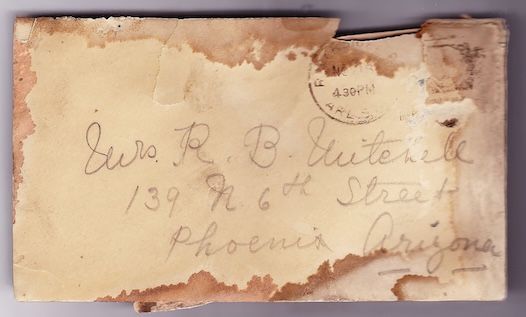 Virginia and R. Bruce Mitchell: Though we’ve been unable to find them in any initial searches online, a letter with an envelope addressed to Mrs. R. Bruce Mitchell (pictured here) was found in Rosson House during its restoration. The letter was sent from Arlington (likely California) and is dated November 18, 1920. However, no return address is included, and it was only signed, “Pa & Ma”.
Virginia and R. Bruce Mitchell: Though we’ve been unable to find them in any initial searches online, a letter with an envelope addressed to Mrs. R. Bruce Mitchell (pictured here) was found in Rosson House during its restoration. The letter was sent from Arlington (likely California) and is dated November 18, 1920. However, no return address is included, and it was only signed, “Pa & Ma”.
Ascension Perez: Born in Mexico, Ascension immigrated to the US in 1920. He was one of the longest-tenured residents at Rosson House, listed there in several Phoenix City Directories from 1923 through 1947, as well as the 1930 and 1940 censuses. He was a cook with Donofrio’s confectionary shop for many years, as well as the San Carlos Coffee Shop and the Pioneer Coffee Shop. He is mentioned in the Arizona Republican newspaper (June 16, 1927), travelling with a group of Phoenix businessmen to the White Mountains of Arizona on a fishing trip as their cook, saying that he was, “noted for his ability as a chef.”
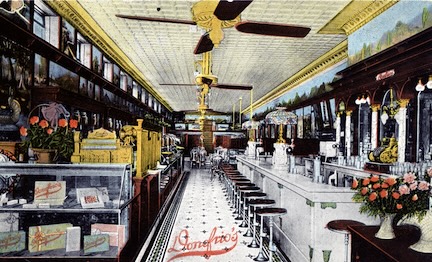
A postcard of Donofrio’s Confectionary, circa 1910.
Alice Schlicker / Slicker: Alice lived at Rosson House in 1926, according to the Phoenix City Directory as well as her voter registration for that year. The directory says she worked as a bookkeeper for Goldwater’s clothing store around the same time as Annie Gammel worked there as a buyer.
Frank and G. Raymond Rudolph: Another set of brothers who lived at Rosson House, Frank and Raymond are listed at the home in the 1928 Phoenix City Directory. Raymond was the secretary and treasurer of the Rudolph Ford dealership, and Frank was a clerk there as well. An article in the Arizona Republican newspaper (August 10, 1928) reported that Frank was arrested at his residence for violating ordinance 1100 – a municipal liquor law. Though the article lists no address, it’s very likely that it was at Rosson House.
Newell Ponder: Brother to Milt Ponder, who married Annie Gammel in 1926, Newell was recorded at Rosson House in both the 1930 and 1940 censuses, but in between lived elsewhere (and was married and divorced within that time). He worked at a filling station and as an electrician’s helper in Phoenix, but the 1950 census lists him in Santa Monica, California, working as a painter with the aircraft industry.
Margaret T. Hurley: Listed in the 1947 Phoenix City Directory, Margaret was a stenographer at the Hurley Packing Co. Though I couldn’t find a direct connection with either, she was likely related to the John C. Hurley who lived at Rosson House with the Higleys in 1912, and was also likely the Margaret T. Hurley from Phoenix who enlisted in the Women’s Army Corps as a stenographer/typist in early 1945.
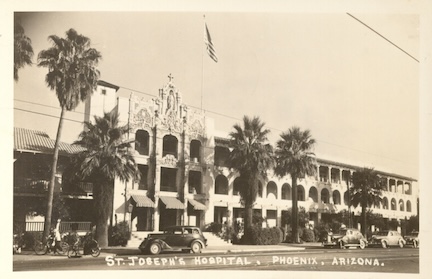
A postcard of St. Joseph’s Hospital, Phoenix, AZ, circa 1940s; Phoenix Public Library, Susan Arreola Postcards Collection.
Frank and Alice Honsik: Frank and Alice were listed in the 1947 Phoenix City Directory at Rosson House, and it’s likely that Frank, a physician and surgeon, was completing his internship at nearby St. Joseph’s Hospital (mentioned in his obituary) while they lived there. Georgia Gammel Valliere remembered that interns from St. Joseph’s Hospital would rent furnished rooms at their home, and this information about Frank appears to confirm that recollection. Alice (maiden name Goeldner) immigrated to the United States from Germany as a child with her family in 1925. She received a nursing certificate from Northwestern, and was in the Cadet Nursing Corps during World War II.
Kai “Speedy” Skounborg: Speedy emigrated from Denmark to the United States as a small child with his family in 1912. He lived at Rosson House from 1963 until 1974, and then as a caretaker in a construction trailer at The Square until his death in 1981. Learn more about Speedy’s life, including his years traveling the country as a unicyclist and entertainer, by reading our blog article about him from September 2024 – Fun on Wheels: Speedy’s Story.
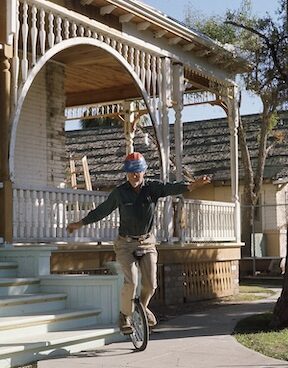
A picture of Speedy on his unicycle at Rosson House, circa 1977.
By the time the Gammels moved from Rosson House, lodging houses were becoming increasingly more rare. In the 1920 Census, the family – including Frankie, Billie, Georgia, Wilma, Annie, and Frankie’s father, Frederick Roberts – were listed living at Rosson House with eight lodgers. In the area around their home, around a quarter of the families had lodgers or boarders living with them. But in the 1950 Census, the number of homes with lodgers there had fallen to fewer than one in ten. Correspondingly, the 1921 City Directory listed 106 places that had “Furnished Rooms” for rent, and by 1950, that number had dwindled to just 8.
Flophouse: A cheap, run-down hotel or rooming house.
Abbie Hazel Burris purchased Rosson House from Georgia Gammel Valliere and her husband in December 1948. The home then went on to change hands six times before the City bought it in 1974 from Armella Demmler, who’d acquired Rosson House in 1956 with her husband, Ludwig. The Demmlers, along with other owners Florence DeCrisci, and Nora and James Compton, all seem to have lived in the house while it was in their possession, but the years still took their toll on the once elegant home. Layers of paint chipped away on the exterior brick and trimwork, while on the interior, dirt, neglect, and poverty made it almost unrecognizable from the building we know today. The home had decayed enough by the 1970s that some restoration workers called it a flophouse. And while we may quibble with “flophouse” as a pejorative term, Rosson House did fit the strict definition found above. However, that doesn’t mean that this lodging house, its function, its owners, nor its many residents don’t deserve to be remembered as a part of our history.
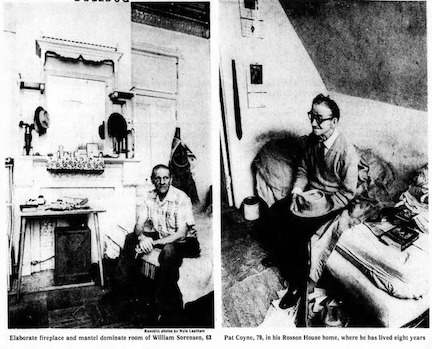
Photos of Rosson House lodgers William Sorensen and Pat Coyne from an article about Rosson House in the Arizona Republic, November 26, 1972, p49.
Miles to go Before We Sleep
I know we haven’t found the names of everyone who lived at Rosson House, and that it’s likely we won’t know everyone who did, since that covers a period of over 70 years. But that’s not going to stop me from trying! There were nineteen people who lived at Rosson House when it was purchased by the City in 1974 – we only know the names of four of those individuals, and I believe that most of the names on our list represent an equally small fraction of those who lived in the home. With more research, I’m hoping to add more people to the list, and to find more information about all the lodgers.
The great news is that our community can help with this project! If you know someone whose name should be on the list, but isn’t, or if you know information about someone who is already on the list, please let us know by filling out our Lodger Information form, available online, and also via both fillable PDF, and printable PDF.
Thank you to long-time volunteer, Vicki Beaver, for her great interviews and research back from when Rosson House as a museum was still brand-new. Though research today has its frustrations, it’s infinitely easier to do it via clicking through a website than it was/is to do by driving downtown and sifting through dusty archives and miles of microfiche like Vicki did!
Learn more about who lived at these historic houses in 1950 by reading our blog article from May 2022, The 1950 Census: Who We Discovered at the Square.
Banner Image: Rosson House lodgers’ collage – includes photo of Rosson House, circa early 1970s, The Square PHX collection; furnished rooms classified ad for 139 N. Sixth Street (Arizona Republic, September 28, 1941); 1931 Phoenix City Directory title; Maricopa County voter registration page headings (1913); Arizona death certificate heading (1950); draft registration card heading (1942); 1950 US Census page heading; and 1949 Sanborn Fire Insurance Map of Phoenix (Rosson House “furnished rooms”, image 17).
Information for this article was found in our organization’s collection and archives, and online through historic documents and records at Arizona Memory Project and Ancestry, and through historic newspaper archives at Chronicling America and Newspapers.com. More information about boarding and lodging houses were found from The Boardinghouse in Nineteenth-Century America, by Wendy Gamber, 2007 (accessed via Internet Archive); The Encyclopedia of Greater Philadelphia – Boarding and Lodging Houses; Colored Conventions – About Black Boardinghouses; and the US Census – The historic rise of living alone and fall of boarders in the United States: 1850-2010 (PDF). Definitions are from Dictionary.com.
Thank you for reading our history blog!
Archive
-
2025
-
November (1)
-
October (1)
-
September (1)
-
August (1)
-
June (1)
-
May (2)
-
April (1)
-
January (1)
-
-
2024
-
December (1)
-
November (1)
-
October (1)
-
September (1)
-
August (1)
-
July (1)
-
June (1)
-
May (1)
-
April (1)
-
March (1)
-
February (1)
-
January (1)
-
-
2023
-
December (1)
-
November (1)
-
October (1)
-
September (1)
-
August (1)
-
July (1)
-
June (1)
-
May (1)
-
April (1)
-
March (1)
-
February (1)
-
January (1)
-
-
2022
-
December (1)
-
November (1)
-
October (1)
-
September (1)
-
August (1)
-
July (1)
-
June (1)
-
May (1)
-
April (1)
-
-
2021
-
December (1)
-
November (1)
-
October (1)
-
September (1)
-
August (1)
-
July (1)
-
June (1)
-
May (1)
-
April (1)
-
March (1)
-
February (1)
-
January (1)
-
-
2020
-
December (1)
-
November (1)
-
October (1)
-
September (1)
-
August (1)
-
July (1)
-
June (1)
-
May (1)
-
April (1)
-
March (1)
-
February (1)
-
January (1)
-
-
2019
-
December (1)
-
November (1)
-
October (1)
-
September (1)
-
August (1)
-
July (1)
-
June (1)
-
May (1)
-
April (1)
-
March (1)
-
February (1)
-
January (1)
-
-
2018
-
December (1)
-
November (1)
-
October (1)
-
September (1)
-
August (1)
-
July (1)
-
May (1)
-
April (1)
-
March (1)
-
February (1)
-
January (1)
-
-
2017
-
December (1)
-
November (1)
-
October (1)
-
September (1)
-
August (1)
-
July (1)
-
June (1)
-
May (1)
-
April (1)
-
March (1)
-
February (1)
-
-
2016
-
2015
-
2014
-
July (1)
-
